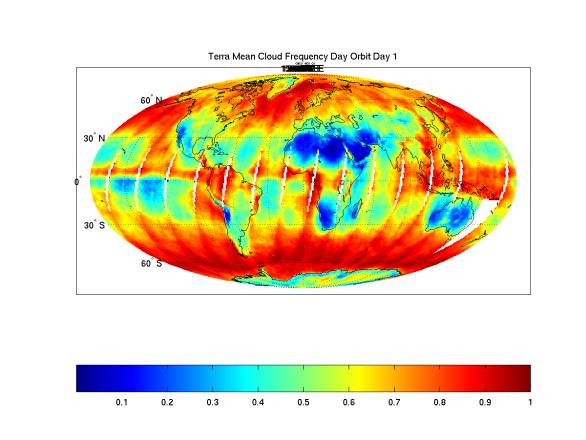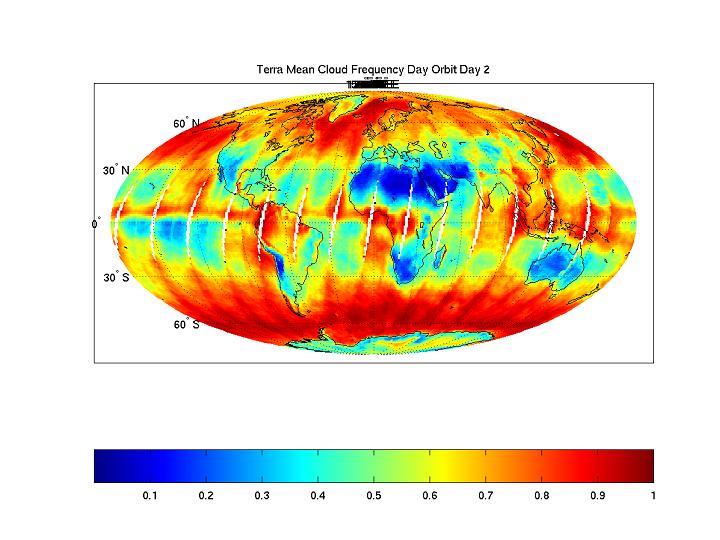


Steve Ackerman
Brent Maddux
Richard Frey
Cloud Property Viewing Geometry Dependencies from Terra
MODIS Terra and Aqua are on a 16-day repeat cycle, meaning that every 16 days they overpass the same areas with the same viewing geometry. This allows for the entire data record to be broken into 16 datasets where each grid cell was observed using similar viewing geometries. Though this will not give us an exact numerical relationship between the viewing geometry and the observed cloud field from MODIS we will be able to gain alot of qualitative insight. Since the orbit of MODIS is most different between two consecutive days we chose Orbit Day 1 and Orbit Day 2.
Below are the first and second orbit day means and the difference of the first and second orbit day for six years of the Terra record(March 2000 - February 2006).
In other words 'Orbit Day 1' consists of the mean of day 1, 17, 33... up to about day 2200 and Orbit Day 2 is for 2, 18, 34..., thus each average is for approxiamtely a 136 day period.
Daytime Cloud Fraction
The three figures below are the mean cloud fraction day for orbit day 1, orbit day 2, and the difference of orbit days 1 and 2. Most notable in these figures is the line occurring to the right of nadir in each swath of orbit day 1 and 2. We can see that the differences in the two days are greatest over areas of climatologically high aerosol optical depths, the u-shaped arc in of maximum differences from the Caribbean to Africa to China.
| Orbit Day 1 | Orbit Day 2 | Orbit Day 1 Minus Day 2 |
 |
 |
|
Daytime Water Cloud Fraction
The three figures below are the mean cloud fraction water for orbit day 1, orbit
day 2 and the difference of orbit days 1 and 2. The orbit day means show a left of nadir
increase in the water cloud fraction. There are also unphysical lines along constant
sensor zenith angle. However, the most notable issue is the sun glint region in stratocumulus
regions off the coast of Peru and Africa in orbit day 1, although it is in orbit day
two as well. This region of relative minimum water cloud fraction occurs over ocean
sunglint.
Intuitively we would expect that viewing geometry differences, due primarily
sensor zenith angle, would be most pronounced in regions with ‘some’ clouds, in other
words not over clear sky or homogenous cloud decks. However, the regions with the
greatest difference is where frequency of water clouds is greatest, e.g. the stratocumulus decks.
| Orbit Day 1 | Orbit Day 2 | Orbit Day 1 Minus Day 2 |
 |
|
|
Daytime Cloud Top Pressure
These figures display the mean daytime cloud top pressure for orbit day 1, orbit day 2 and the difference of orbit days 1 and 2. The cloud top pressure figures agree well with the cloud fraction figures above; with a maximum cloud top pressure near nadir with relatively high cloud top pressures towards the edge of scan. This would indicate that thin, diffuse clouds are detected higher in the atmosphere at high viewing zenith angle then near nadir. The one interesting note is the reversal in viewing geometry dependence over bright surfaces, e.g. the Sahara Desert.
| Orbit Day 1 | Orbit Day 2 | Orbit Day 1 Minus Day 2 |
|
|
|
|